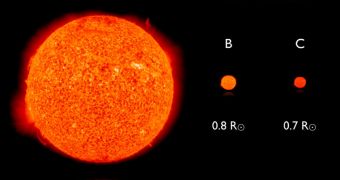The NASA Kepler planet-hunting telescope recently managed to make another impressive finding. Experts were able to use the data it collected to determine the existence of a previously-unknown triple-stars system.
It was only through the ultra-precise, space photometry capabilities of this amazing telescope that such studies can be conducted, experts at NASA said. Kepler is primarily used to search for extrasolar planets around other stars, but other applications are possible as well.
One of them is making out subtle variations in the brightness output level of a star, and figuring out whether the change was caused by an exoplanet or by another type of celestial body. This is precisely what the observatory did in the case of the triple-star system.
The observatory's capabilities were used to peer at the heart of a star previously thought to be a single object. But the in-depth analyses revealed that the celestial fireball was in fact a collection of three stars, that were orbiting each other.
The European, Australian and American astronomers that conducted the research dubbed the object HD 181068, and nicknamed it Trinity. Details of how this system functions have been accepted for publication in an upcoming issue of the prestigious journal Science.
According to the group, the system is made up of a red giant star – which is also visible from Earth with the naked eye, but appears to be alone in the sky – and two red dwarfs. The latter two orbit each other at high speeds, and together orbit the former.
Researchers say that the three objects were discovered to have an interesting geometrical disposition among themselves, which allows each of them to go through eclipses rather often. The system's period of ration has been established to be 45.5 days.
“Thanks to the fortunate viewing angle from Earth, the combined light from the three stars change very characteristically: there are sharp brightness decreases with a period of 0.9 days produced by the mutual eclipses of the close pair of dwarfs, while it takes 2 days for the close pair to pass in front of or behind the red giant,” expert Aliz Derekas says.
The astronomer, who is the lead author of the new paper, holds an appointment at the Eotvos University and Konkoly Observatory, in Budapest, Hungary.
“Spectroscopic measurements revealed the periodic motion of the largest star in the system with the wide orbital period of 45,5 days. The 2-day long eclipses are so similar at first sight that we thought that the outer orbital period is 22.7 days,” adds Laszlo Kiss, quoted by Universe Today.
“Only after having obtained the whole radial velocity curve, we realised the tiny differences in the long period minima and that the real period was the double of it,” concludes Kiss, who is based at the Konkoly Observatory. He is also an author of the new paper.

 14 DAY TRIAL //
14 DAY TRIAL //